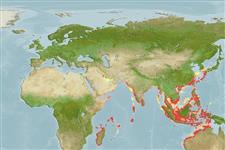sub class Elasmobranchii (ฉลามและกระเบน) (sharks and rays) >
Orectolobiformes (Carpet sharks) >
Hemiscylliidae (Bamboo sharks)
Etymology: Chiloscyllium: cheilos (Gr.), lip, referring to membranous and broad lower lip, presumably of C. plagiosum (proposed without a species); skylion, Greek for dogfish or small shark. (See ETYFish); plagiosum: -osus, Latin suffix denoting fullness or abundance: plagis (L.), stripes, referring to dark transverse bands on body. (See ETYFish).
Environment: milieu / climate zone / depth range / distribution range
นิเวศวิทยา
เกี่ยวกับทะเล,น้ำเค็ม เกี่ยวกับหินโสโครก; ระดับความลึก 0 - 50 m (Ref. 106604). Tropical; 35°N - 10°S, 42°E - 135°E
Indo-West Pacific: India and Maldives east to Papua New Guinea north to Japan, south to Indonesia. Reported from Korea (Ref. 45255).
Length at first maturity / ขนาด / น้ำหนัก / Age
Maturity: Lm 56.5, range 50 - 63 cm
Max length : 83.0 cm TL เพศผู้/กระเทย; (Ref. 43278); 95.0 cm TL (female); อายุสูงสุดที่ได้รายงาน: 25 ปี (Ref. 72467)
เงี่ยงครีบหลัง (รวม): 0; ก้านครีบอ่อนที่หาง (รวม): 0; เงี่ยงครีบก้น 0; ก้านครีบอ่อนที่ก้น: 0. Genus: Nostrils subterminal on snout; pre-oral snout long, mouth closer to eyes than snout tip; eyes and supraorbital ridges hardly elevated; no black hood on head or large spot or spots on sides of body above pectoral fins (Ref. 43278). Caudal fin with a pronounced subterminal notch but without a ventral lobe (Ref. 13575). Genus: Nostrils subterminal on snout; pre-oral snout long, mouth closer to eyes than snout tip; eyes and supraorbital ridges hardly elevated; no black hood on head or large spot or spots on sides of body above pectoral fins (Ref. 43278). Caudal fin with a pronounced subterminal notch but without a ventral lobe (Ref. 13575).
Species: Young and adults with transverse dark bands and numerous white or bluish spots (Ref. 13575, 43278). Body with lateral dermal ridges (Ref. 43278, 13575).
A common but little-known inshore bottom shark (Ref. 247); found on rocks and coral reefs (Ref. 90102). Feeds on bony fishes and crustaceans (Ref. 43278). Oviparous (Ref. 43278, 50449). Utilized for human consumption (Ref. 247) and used in Chinese medicine (Ref. 12166). Caught by multiple hook and line and trawl (Ref. 47736). Caught rarely by demersal gillnet fisheries operating inshore (Ref.58048).
Life cycle and mating behavior
วัยเจริญพันธุ์ | การสืบพันธุ์ | การวางไข่ | เซลสืบพันธ์ของเพศเมีย(ไข่) | ความดกของไข่ | ตัวอ่อน
Oviparous, paired eggs are laid. Embryos feed solely on yolk (Ref. 50449). Hatches at 10-13 cm TL. In Taiwan, hatching occurs in June to August (Ref.58048).
Compagno, L.J.V., 1984. FAO Species Catalogue. Vol. 4. Sharks of the world. An annotated and illustrated catalogue of shark species known to date. Part 1 - Hexanchiformes to Lamniformes. FAO Fish. Synop. 125(4/1):1-249. Rome, FAO. (Ref. 247)
IUCN Red List Status (Ref. 130435)
Threat to humans
Harmless
Human uses
การประมง: การค้า
ข้อมูลเพิ่มเติม
อ้างอิงการเพาะเลี้ยงสัตว์น้ำประวัติการเพาะเลี้ยงสัตว์น้ำสายพันธุ์พันธุศาสตร์ElectrophoresesอัตราพันธุกรรมโรคการแปรรูปNutrientsMass conversion
ผู้ร่วมมือรูปภาพหลายรูปStamps, Coins Misc.เสียงปลามีพิษ เช่น ปลาปักเป้าความเร็วรูปแบบการว่ายน้ำพื้นที่เหงือกOtolithsสมองวิสัยทัศน์
เครื่องมือ
Special reports
Download XML
แหล่งที่มาจากอินเตอร์เน็ต
Estimates based on models
Preferred temperature (Ref.
123201): 25.3 - 29.1, mean 28.7 °C (based on 1458 cells).
Phylogenetic diversity index (Ref.
82804): PD
50 = 0.5039 [Uniqueness, from 0.5 = low to 2.0 = high].
Bayesian length-weight: a=0.00407 (0.00181 - 0.00918), b=3.09 (2.89 - 3.29), in cm total length, based on LWR estimates for this (Sub)family-body shape (Ref.
93245).
ระดับชั้นอาหาร (Ref.
69278): 4.0 ±0.67 se; based on food items.
Generation time: 6.1 ( na - na) years. Estimated as median ln(3)/K based on 2
growth studies.
ความสามารถในการกลับคืนสู่ปกติ (Ref.
120179): ต่ำ, เวลาต่ำสุดที่จะทำให้ประชากรเพิ่มขึ้นเป็น 2 เท่าใช้เวลา 4.5 - 14 ปี (Fec assumed to be <100).
Fishing Vulnerability (Ref.
59153): Moderate vulnerability (36 of 100).
Nutrients (Ref.
124155): Calcium = 18 [4, 70] mg/100g; Iron = 0.44 [0.11, 1.21] mg/100g; Protein = 19.7 [17.4, 21.8] %; Omega3 = 0.0938 [, ] g/100g; Selenium = 29.8 [8.0, 80.9] μg/100g; VitaminA = 43.7 [15.7, 112.0] μg/100g; Zinc = 0.791 [0.379, 1.672] mg/100g (wet weight);
